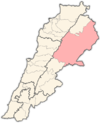Saraain El Faouqa
سرعين الفوقا Serain, Serain Al Fawka, Saarain | |
|---|---|
Village | |
| Country | |
| Governorate | Baalbek-Hermel |
| District | Baalbek |
| Alternative name | Serain, Serain Al Fawka |
|---|---|
| Location | 6 kilometres (3.7 mi) northeast of Rayak, Lebanon |
| Coordinates | 33°52′43″N 36°05′34″E / 33.87864°N 36.09288°E |
| Type | Surface site and Roman temple |
| History | |
| Periods | Mousterian, Levalloiso-Mousterian, Shepherd Neolithic, Ancient Rome |
| Site notes | |
| Excavation dates | 1946 |
| Archaeologists | Henri Fleisch |
| Public access | Yes |
Saraain El Faouqa (Arabic: سرعين الفوقا) is a village located 6 kilometres (3.7 mi) northeast of Rayak in Baalbek District, Baalbek-Hermel Governorate, Lebanon.[1] Most of its inhabitants Shia Muslims and a minority are Maronites.[2]
Archaeology
There is an archaeological site located on the right of the road from Rayak, immediately before the village. It was discovered by Henri Fleisch in 1946 and mentioned by L. Burkhalter in a list of prehistoric sites published in 1948.[3] Various small bifaces, flakes and cores were found that were originally assessed to be Mousterian by Burkhalter. Fleisch was said to "deplore the lack of typology" to distinguish the assemblage, but suggested some pieces were similar to Levalloiso-Mousterian and the Shepherd Neolithic tools found at Rayak North and Fleywe.[1]
Roman Temple, quarry and tombs
The village of Sarain El Faouqa is suggested to have been built on the remains of a Roman quarry. There is a Roman temple on the left within the village that is included in a group of Temples of the Beqaa Valley. There are also numerous rock-cut tombs visible nearby. Although the walls of the temple cella have long since disappeared, the podium still remains. Further remains were found when a house that had been built on the temple was demolished, revealing part of a cast door frame, a block from the ceiling and parts of a column base and shaft.[4][5]
References
- ^ a b L. Copeland; P. Wescombe (1966). Inventory of Stone-Age Sites in Lebanon: North, South and East-Central Lebanon, p. 52. Impr. Catholique. Retrieved 3 March 2011.
- ^ "Municipal and ikhtiariah elections in the Beqa'a 147 municipalities and 414 mokhtars" (PDF). The Monthly Magazine. February 2010. Archived from the original (PDF) on 2016-03-04.
- ^ Burkhalter, L., Bibliographie préhistorique - Inventaire, Bulletin du Musée Beyrouth, Volume 8, 1948.
- ^ George Taylor (1971). The Roman temples of Lebanon: a pictorial guide. Les temples romains au Liban; guide illustré. Dar el-Machreq Publishers. Retrieved 13 October 2012.
- ^ Othmar Keel (1997). The Symbolism of the Biblical World: Ancient Near Eastern Iconography and the Book of Psalms. Eisenbrauns. pp. 159–. ISBN 978-1-57506-014-9. Retrieved 13 October 2012.
External links
- Serraaine El Faouqa, Localiban
- Serain Al-Fawka on middleeast.com
- Saraain El Faouqa on geographic-data.net
- Saraain El Faouqa on geonames.org


